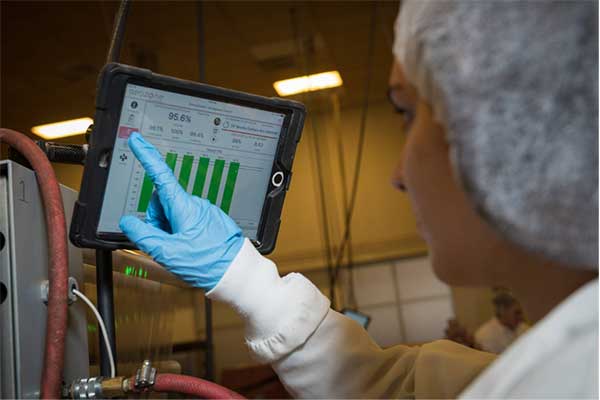
Industry’s Media Platform of Choice
Champion Your Brand in Front of Decision Makers and Extend Your Reach Get Featured in the SPOTLIGHT

Industry’s Media Platform of Choice
Champion Your Brand in Front of Decision Makers and Extend Your Reach Get Featured in the SPOTLIGHT
Learning the value of root cause problem-solving activities to understand how to empower and sustain change within manufacturing.

The manufacturing industry has been up against monumental challenges over the past decade. Manufacturers are facing increased demand from consumers who want high volumes of products almost immediately, without a properly-staffed labor force. There is an overwhelming amount of technology offerings that promise to improve these supply constraints, but many have a high barrier to entry, leaving plant managers unsure of which path to take.
With these complications showing no signs of slowing down and industry leaders feeling mounting pressures to provide results, it can be easy to take a “band-aid” approach to solving problems that arise on the manufacturing floor. While quick-fix solutions may seem practical in the moment, they can create long-term consequences for productivity and profitability. It is critical to understand why taking a root-cause approach to problem solving is of the utmost importance and how it can help boost overall productivity and maximize worker efficiency through technology.
When issues arise on the manufacturing floor, supervisors or the frontline workers themselves often take a “band-aid” approach to solving these problems quickly and inexpensively, though not holistically. You may have seen these first-hand when someone simply uses a zip tie to position a printing head, or bolts a piece of equipment down to minimize the growing vibrations, or even adds a temporary manual step to get the customer order delivered. Though these temporary fixes may get things up and running quickly, they pave the way for negative long-term consequences because the root cause of the issue is left untouched. What if the vibration became catastrophic and led to equipment failure, or even worse, an injury? What if that quick-fix manual process was left and never built into the pricing model?
Instead, plant managers and frontline teams should implement the simple “5 Whys” problem-solving technique for a more comprehensive fix. The concept was originally pioneered by Sakichi Toyoda, founder of Toyota Industries, in the 1930s, and it remains a core foundation of the company to this day. With this technique, teams solve problems by continuing to ask “why” at least five times until they get to the root cause of the issue. This ensures decision making is based on an in-depth understanding of what’s actually happening on the shop floor rather than what someone may assume at first glance, which will often only address the symptoms, only the first why – not the actual problem.
Within manufacturing specifically, the “5 Whys” is particularly effective at identifying the cause of defects or quality issues that can hinder factory output. This technique also can encourage teamwork and collaborative problem-solving, leading to increased employee engagement. Perhaps most importantly to decision makers, implementing this idea is quick, inexpensive and intuitive. Interestingly enough, often the true root cause solution will be lower cost, easier to sustain than the band-aid fixes.
Though these analyses can easily be done by workers at every level, the responsibility lies with plant leaders to ensure employee success. The first step is implementing proper training processes to help employees understand the value of these practices and how they achieve a holistic understanding of plant operations. One of the most impactful training mentalities is “watch one, do one, teach one,” where employees see a colleague demonstrate how to do something and have a chance to do it for themselves in a fully hands-on capacity. Eventually, those folks own the responsibility of passing the baton on and upskilling the next group. The best learning is done on the floor, rather than in a classroom, primarily because it is practical and meaningful, but also because it keeps employees engaged and helps boost productivity and employee retention.
Additionally, plant leaders should create an environment where frontline teams have ownership over their own performance. Over the last decade, new connected technology platforms have emerged with the goal of giving employees a voice and the ability to tap into the informal networks that exist in their plants. According to a recent study that examined how technology and automation help to boost employee engagement and increase productivity, it was found that ownership of performance saw an increase of 112% when integrated with technology. This statistic reinforces how frontline workers desire empowerment to own the results of their production line, including understanding what “winning” means for their company, focusing on improving processes, and hearing real-time feedback. Just think if the 5-why’s solution was coupled with real time visibility, allowing the team to visualize and celebrate the results of their process enhancement. This type of increased engagement results in reduced employee turnover and improved team productivity. A more productive workforce churns out more end product, which means fewer supply chain interruptions, decreased inflation rates and, ultimately, more products on shelves.
As the manufacturing industry continues to grow and evolve, new issues will always arise. The best path forward is creating an inquisitive and connected workforce that feels empowered to find holistic, creative solutions to everyday problems before they create lasting impacts on a company’s bottom line.

About the Author:
Zack Sosebee is Senior Vice President of Operations at Redzone. Zack is responsible for the entire customer experience at Redzone, including the coaching, implementation and support — but most importantly, the results. His team has a mission to be people-focused above anything else.
Having joined Redzone via Ignite Solutions, Zack was part of the early Redzone team, focusing on building out the coaching organization and providing clear, sustainable, bottom-line results to each Redzone customer. Prior to Redzone, Zack was Vice President of Operations for Ignite Solutions from 2011-2013, where he embraced a new love for the Food & Beverage industry through developing and deploying CI and lean manufacturing principles. Zack holds both a bachelors and masters in Mechanical Engineering from Georgia Institute of Technology.
A childhood in Kansas, college in California where she met her early mentor, Leigh Lytle spent 15 years in the Federal Reserve Banking System and is now the 1st woman President & CEO of the Equipment Leasing & Finance Association. Join us to hear about her ambition to be a great leader.